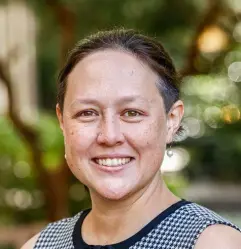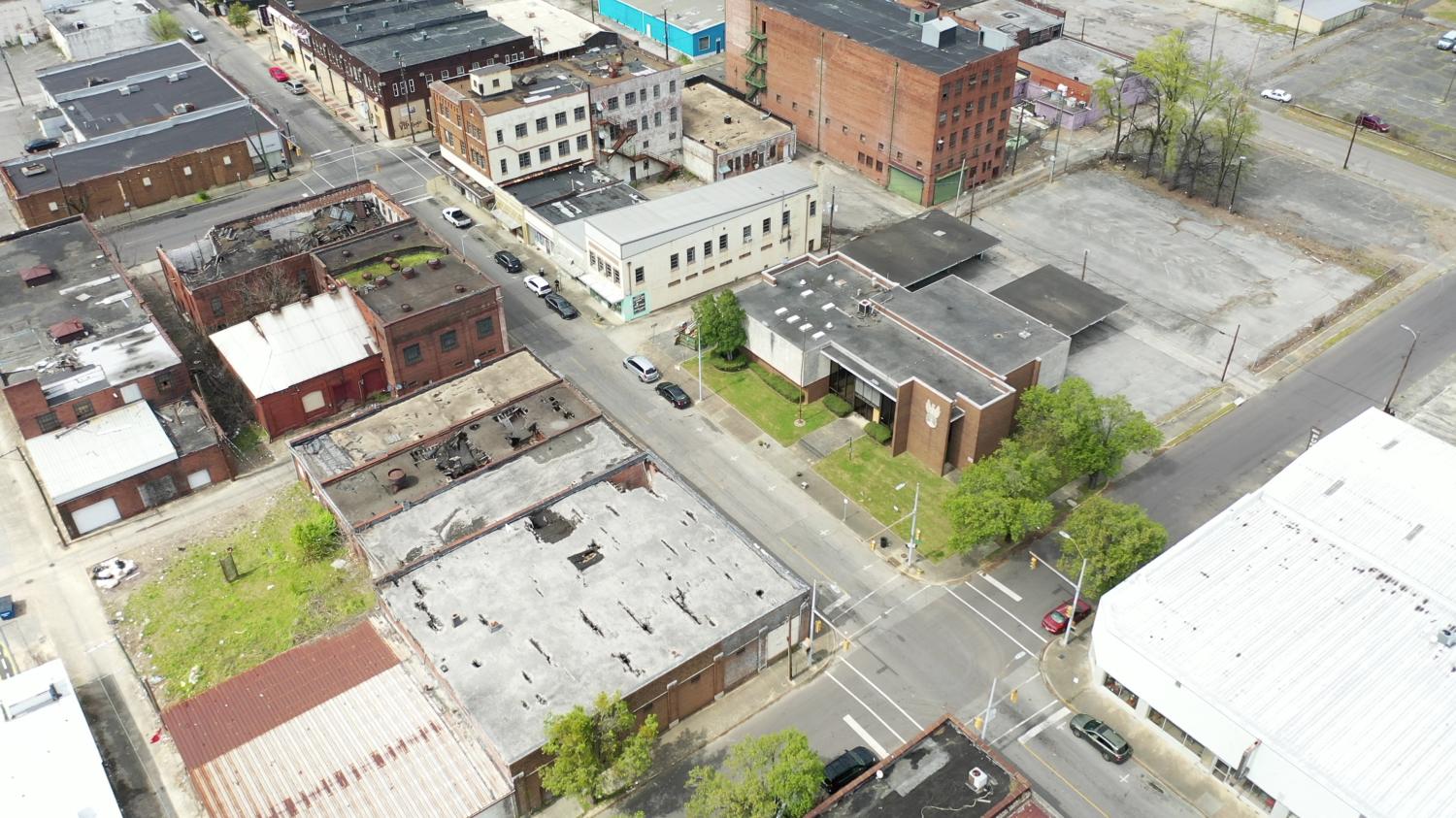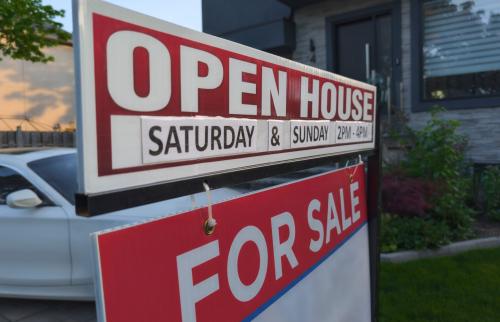This brief is part of the Brookings Blueprints for American Renewal & Prosperity project.
In the United States, the neighborhood in which one lives has always influenced access to economic opportunity. Place-based inequities by race and income—stemming from decades of discriminatory policies and practices—have only become more exposed and more devastating amid the health and economic fallout of the COVID-19 pandemic.
On the whole, place-based policies aimed at addressing social and economic disparities have made few dents in the systematic exclusion of certain people and neighborhoods. While numerous federal programs have been specifically targeted toward areas with high concentrations of low-income residents, they have generally centered more on attracting outside investment to grow jobs and businesses rather than advancing local empowerment and economic mobility through wealth-building.
This brief suggests a different approach to inclusive neighborhood revitalization, proposing that the federal government partner with state and local governments to facilitate the local ownership of real estate in disinvested urban and rural commercial corridors, many of which the COVID-19 economic downturn has hit hard.
What: The federal government should establish and capitalize state revolving loan funds that would provide direct seed funding to locally managed neighborhood investment funds that allow residents—together with other private, public, and nonprofit sector investors—to purchase and develop or redevelop land or buildings in communities meeting recommended criteria.
Where: The federal government should use specific criteria, which we recommend here, for identifying eligible communities in which such funds could be used to support state-selected and locally selected projects.
Who: The federal government should couple capitalization of these funds with support for new or existing hyperlocal governance entities to manage the funds in ways that represent the voices of both the investors and the wider community.
Cities and regions will not recover from the impacts of COVID-19 unless they grapple with how long-standing structural disadvantages associated with place diminish economic opportunity. The program proposed here addresses place-based inequities head on by supporting investment in real estate projects through structures that encourage locally led growth and revitalization from which community residents can materially benefit.
Challenge
The COVID-19 pandemic in the U.S. has exposed long-standing economic and social divides by race, income, and—increasingly—geography. Across the country, coastal metro areas such as Seattle, San Francisco, and New York City have been capturing a disproportionate share of growth in the digital economy for years, while small and midsized cities and rural areas struggle to keep pace.1Within regions, a long history of structural racism—achieved and perpetuated through stolen ownership, capital withholding, and community destruction—has led to wide and growing economic disparities between people and across neighborhoods.2
COVID-19 death rates have laid bare the long-term effects of discrimination and spatial segregation, with Black Americans dying at 2.1 times the rate of white Americans, while Latino or Hispanic Americans are dying at 1.1 times the rate for whites.3 Low-income and minority communities have borne much of the economic damage of the pandemic as well, particularly businesses and commercial corridors already challenged by decades of disinvestment. The effects of disinvestment manifest in several key challenges, including:
- A lack of choice and access. Nationally, neighborhood access to goods and services is fairly even with respect to income, but not with respect to race. Supermarkets are much more commonly located in high-income, majority-white neighborhoods than in low-income, majority-Black neighborhoods.4 This limited availability of food retail in low-income areas contributes to relatively higher grocery costs.5 Beyond grocery, retail establishments in general are significantly underrepresented in Black communities, regardless of their average income levels. Across the 192 largest U.S. metro areas, census tracts where the population is more than 80% Black have less than half as many retail establishments per capita as tracts with a population that is less than 20% Black.6 Because conventional retail is underrepresented in Black communities, the prevalence of predatory retail establishments (liquor and tobacco stores, bars, payday loan and check-cashing centers, pawnshops, and dollar stores) is disproportionately high. The disparate impact of COVID-19 on small and local businesses7 will likely exacerbate this pattern.
- A lack of local ownership and empowerment. The absence of local retail (and especially locally owned retail) that forces residents of majority-Black neighborhoods to shop elsewhere can cheat communities of the benefits of a strong small local business ecosystem.8 Money spent locally puts money in the pockets of shopkeepers and store employees, and generates sales tax revenue for state and local government coffers. This tax revenue then kicks off a second round of public and private spending and investment that magnifies the impact of the initial cash injection. The value of this local multiplier depends upon the extent of “leakage,” or the share of spending that is not recirculated within the local economy (i.e., whether purchases are made at locally owned or national chain retailers).9 Estimates by a leading business analysis firm suggest that purchases from local, independent retailers result in recirculation in the range of 50% to 70%, while local purchases from national chains yield a recirculation rate of less than 14%.10 The pandemic is likely to accelerate these leakages; the measures necessary to contain COVID-19 have favored the largest retailers with both the reserves to implement and scale e-commerce architecture and the capacity to mix essential grocery and pharmacy goods with durable inventory, delivering record profits to Walmart, Amazon, Kroger, Costco, and Walgreens (the five largest retailers in the U.S.) while weakening locally owned stores.11
- A destabilized tax base that inhibits revitalization and investment. The inability of local entrepreneurs to start and successfully maintain a business has reverberating effects on commercial corridors and their surrounding neighborhoods. High commercial vacancy rates saddle communities with distressed assets that destabilize the tax base by undermining commercial property values and reducing assessments—which in turn can hurt residential property values.12 Vacant and deteriorating streetscapes also drag down the success of other businesses in the area through loss of foot traffic, inhibiting street life, and creating a vacuum into which safety and security issues—both real and perceived—can creep. At the neighborhood scale, these conditions further deter traditional retail, continuing the cycle of disempowerment. At the jurisdictional scale, the conditions undermine the fiscal stability needed to make investments (infrastructure or otherwise) that help communities thrive. The pandemic has necessarily reduced sales tax revenue from experience-based retail (e.g., hospitality and tourism), further weakening the fiscal position of states and local jurisdictions.
Cities and regions will never fully recover from the economic effects of COVID-19 without reckoning with the long-range social and economic consequences of discriminatory policies and practices on people and neighborhoods. This demands federal, state, and local policies and strategies that encourage real estate investment in structurally disadvantaged communities and provide their residents the opportunity to both shape and benefit from that development.
Limits of historic and existing policies
Education and homeownership are long-standing pillars of federal policy promoting economic mobility.13 However, disinvestment in places can lead to vast inequities in the viability of these policies, as well as in access to goods and services, basic amenities, employment, and—ultimately—economic opportunity.
Recognizing this, in recent decades federal leaders have implemented several programs specifically targeted toward communities with high rates of poverty, unemployment, and other characteristics of “need.” But these programs have had limited success in fostering opportunity and mobility, in large part because they have not generally applied the right tools to the right locations with the right local partners. More broadly, place-based programs have not centered on advancing local ownership, empowerment, and wealth creation.14
A brief history of federal place-based policy
Federal place-based policy has significantly evolved over the past half-century. In the wake of the civil rights movement, a collaborative, bottom-up approach to urban policy emerged as a means of counteracting concentrated poverty, giving rise in the 1970s to the Community Development Block Grant (CDBG) program, the Community Reinvestment Act, and other initiatives targeted toward funneling public and private dollars into low-income areas.15In the decades that followed, federal policymakers came to view community-building as a more holistic enterprise, recognizing that investment in physical redevelopment at the neighborhood level had to be accompanied by services and supports designed to grow jobs, businesses, and organizational capacity in low-income areas.
To this end, in the early 1990s, the Department of Housing and Urban Development (HUD), together with the Department of Agriculture, pioneered the Empowerment Zone/Enterprise Community (EZ/EC) program: a set of initiatives primarily designed to move businesses to and increase job opportunities in communities with high unemployment and poverty rates. The program—which provided varying levels of grant funds and tax credits16 was succeeded years later by the Obama administration’s more expansive urban policy agenda, which aimed to carefully review federal place-based policy efforts in areas ranging from housing to education to criminal justice, and institutionalize initiatives designed to maximize impact across federal agencies.17 However, with no congressional support to appropriate funds, Obama-era programs such as StrikeForce and Promise Zones were essentially limited to technical assistance and capacity-building in a very small number of pilot locations.18
Today, federal place-based policy touches the lives of millions of Americans. The New Markets Tax Credit (NMTC) program—created in 2000 to provide capital in qualified entities in low-income communities for a variety of purposes—is likely the single most impactful place-based policy in U.S. history, and continues to provide billions of dollars to businesses and projects in low-income communities. Likewise, the CDBG program directs billions in block grants each year to low- and moderate-income communities and place-based organizations. Most recently, the 2017 Tax Cuts and Jobs Act established Opportunity Zones, a Treasury Department-administered program that forgives capital gains tax obligations in exchange for patient capital invested in designated low-income census tracts.
Table 1. Comparing various federal approaches to place-based policy
| Name | Agency | Total Cost | Timeframe | Reach | Purpose |
| Community Development Block Grant (CDBG) | HUD | $37.2 billion in grants as of 201519 | 1974 – present | National | To benefit low- and moderate-income communities with aging built environments and limited economic opportunities |
| Community Reinvestment Act (CRA) | FRB, FDIC, OCC | Absorbed by agencies | 1977 – present | > 3,600 LMI tracts | To restore access to capital to historically redlined communities |
| Enterprise Communities/ Empowerment Zones (EC/EZ) | HUD | $1.784 billion in grant incentives (1993 – 2009)20 | 1994 – 2016 | 40 EZs, 95 ECs | To increase job opportunities in structurally disadvantaged communities |
| New Markets Tax Credit (NMTC) | Treasury | $57.5 billion as of 201921 | 2000 – present | Low-income communities as defined by statute | To provide capital to qualified community development entities |
| StrikeForce initiative | USDA | $23.5 billion as of 201622 | 2010 – 2017 | 970 counties in 25 states and Puerto Rico | To combat rural poverty |
| Promise Zones (PZ) | 13 federal partners | No additional costs to partners | 2014 – present | 22 zones | To increase economic activity, improve education, reduce crime, enhance public health, and address local priorities |
| Opportunity Zones (OZ) | Treasury, IRS | $11.2 billion23 | 2018 – present | 8,764 census tracts across all states and territories | To spur economic growth and job creation in low-income communities |
A three-part critique of place-based policy design
While billions of dollars have been spent on federal place-based programs over the decades, their success in improving the economic and social well-being of community residents has been mixed at best. This is in part because such programs are implemented within a larger context of both market challenges and federal, state, and local policy structures that they aren’t designed or funded enough to remedy. However, many of these programs have also missed the mark because they aren’t targeted at the right challenges (the “what”) in the right places (the “where”) in partnerships with the right local actors (the “who”).
The mechanism of intervention (the “what”) is often not appropriately connected to the challenges facing structurally disadvantaged communities. The stated purpose of most place-based federal programs has generally been to drive business growth, job creation, and investment in low-income communities. But there are often several inherent flaws in the programs’ design that limit connectivity between these outcomes and improved economic opportunity for residents.
First, few (if any) place-based programs have been structured to meet these objectives by supporting local business ownership and growth. Instead, they have focused primarily on attracting investment from outside the community. The stated purpose of the Opportunity Zone program, for example, “is to spur economic growth and job creation in low-income communities while providing tax benefits to investors.”24 But OZs are explicitly designed to target low-income communities with outside capital, without any mechanism to commit this capital to increasing wages, creating new job opportunities for residents, or offering entry points for residents to ownership of properties or businesses. Hence, OZ funds are leveraged for extremely marginal uses in some cases, such as self-storage facilities and data centers. Similarly, although the primary purpose of the NMTC program is to encourage economic development in particular geographic areas, parking construction is an eligible project activity, and its incentives do not target local ownership.25
Further, sometimes the tools themselves are misaligned, rendering them ineffective toward meeting their intended goals. For example, the EZ/EC program utilized block grants in combination with a package of tax incentives to stimulate business and job growth. But uptake (and thus impact) of these incentives was limited because not all of the incentives were used by local businesses, many of which had limited tax liability.26 Moreover, using foregone tax revenue as the primary funding mechanism, as with NMTCs and OZs, means that the market must provide the cash upfront and bear all the risk. This encourages investments to go toward strong projects that might have attracted private investment anyway absent the taxpayer subsidy, and leaves socially beneficial projects still struggling to access capital.27Past place-based policies have often targeted the wrong places (the “where”) either by being too expansive and diffusing impact, or by overweighting political priorities in their map. In order to maximize the impact of a policy in relation to its intention, the right intervention must be connected to the right places. However, eligibility criteria for program participation can undermine this connection. Some place-based policies establish criteria that is too broad and poorly targeted. For example, places eligible for NMTCs contain roughly 40% of the U.S. population (though credits are awarded competitively); CDBG is even more expansive in its coverage.28 Other place-based economic development programs have narrowly centered on very low-income communities that face high and multiple market obstacles to business and job growth, rather than on “middle neighborhoods” where federal intervention could be a key stabilizing force.29 For example, the EZ/EC program included many areas whose markets were generally so weak that grant funding and tax incentives failed to catalyze substantial long-term investment.
Moreover, eligibility criteria can create loopholes that enable the influence of political motivations and undercut stated program objectives, as what happened with Opportunity Zones. Thus, there are designated OZs that do not have any resident population, and OZ funds facilitating development in remote areas like the Arctic Circle.30Finally, many federal programs have either not prioritized community leadership and expertise (the “who”) or haven’t invested in building it. Without high-capacity local partners in implementation, program targets may not know about, trust, or be in a position to take advantage of program tools. A key takeaway of the Obama administration’s place-based policy efforts—including Promise Zones, the Strong Cities, Strong Communities Initiative, the Sustainable Communities Initiative, and the Neighborhood Revitalization Initiative—was the need to build capacity at the local level.31 And evaluations of the EZ/EC program have found that the strength of local operating organizations was a defining factor in whether or not a designated zone achieved program goals.32 Indeed, one of the reasons NMTCs have achieved longevity is because they are deployed through certified community development entities, which are generally high-capacity organizations that are required to have a primary mission of serving low-income communities.33
On the flip side, Qualified Opportunity Funds (QOFs), which are simply tax entities, administer Opportunity Zone investments. These entities may have no local connection to a particular OZ beyond the investment—and thus have no obligation to invest in projects that existing residents can take ownership in or even want.34 This may be fine if the program objective were to maximize investor returns, but not when the intended goal is to provide widespread community benefit.
Policy recommendation
This proposal builds on the accumulated lessons of over a half-century of place-based policy to recommend a more targeted, next-generation approach characterized by greater precision to the “what,” “where,” and “who” of place-based policy. The federal government can revitalize struggling neighborhoods and advance economic justice and mobility by partnering with state governments and local organizations to facilitate the creation of investment funds that enable the local ownership of real estate in eligible urban and rural commercial corridors.
The “what”: The recommended program has several defining features:
Direct seed funding. Through this program, the Treasury Department would establish and capitalize state revolving loan funds that would provide direct seed capital through a combination of low-interest, potentially forgivable debt and working equity to locally managed neighborhood investment funds. A one-time, $2 billion capitalization of these funds would yield $80 million at 4% interest to loan annually without touching the principal. A 10% add-on to each transaction for working equity to support local capacity-building would consume less than 0.5% of the principal balance.
Although such cash investments are more difficult to legislate than tax credits, abatements, or tax increment financing, they are critical to catalyzing local real estate projects, as they can accelerate the process of attracting other investors, thicken the capital stack, and expedite the timeline for project realization. As in other economic downturns, the COVID-19 recession has already begun to trigger rapid changes in land markets, with affluent speculators purchasing real estate holdings and taking advantage of financially vulnerable small businesses, low-income households, and individual property owners. Public sector investment in neighborhood investment funds would help local entities quickly assemble property and then hold it as investors are brought together to finance projects that are part of a more locally driven revitalization strategy.
Resident investment and benefit. The local neighborhood investment funds would allow residents of eligible geographic areas—together with other public, private, and nonprofit investors—to collectively purchase and develop or redevelop land or buildings in commercial corridors in those areas. A principal objective of these funds would be to acquire a significantly large portfolio of properties to catalyze neighborhood transformation. Beyond that, the aim is also to increase local ownership of real estate, allowing residents to both influence and build wealth from projects in their communities.
State and local partnerships. State governments would be responsible for managing the applications for specific projects to access revolving loan fund dollars. They would also be responsible for identifying the local partners, or partnership configurations (described below) to manage the local investment funds.35Alignment with Opportunity Zones. This program could—but wouldn’t necessarily have to—work in conjunction with existing Opportunity Zones. Opportunity Zones are fundamentally designed to influence investor behavior, and the current program directs Qualified Opportunity Fund (QOF) investors to particular areas (the designated OZs). The next step would be to create a mechanism and incentive for QOFs to engage local partners in specific places, as well as enable small-dollar local investors to participate. This mechanism could also provide downside risk protection for these investors.
The “where”: The federal government should set criteria to identify eligible census tracts where state revolving loan funds could be deployed. State and local governments would then select projects in commercial corridors within those tracts for participation in the program.
Broadly speaking, these criteria must target areas that have some prospect for economic turnaround beyond that which will be derived from this program alone. If the intention is to enable resident investors to explicitly benefit from redevelopment projects, there must be some preconditions for growth present and some assets for investment to scaffold onto, such as potential transit-oriented development, anchor institutions like universities and hospitals, existing initiatives aimed supporting local entrepreneurship and business incubation, cultural activity clusters, or commitments to build rural infrastructure.
Equally important is that eligible communities are those that can retain and recirculate the invested capital. The concept of “capital absorption” is helpful here, and it is long past time that federal place-based policies reflect it.36 The urbanist Jane Jacobs once wrote that capital flows into urban neighborhoods tend to have the effect of either “floods” or “droughts.” In either case, the problem stems from the community’s inability to absorb this capital. What is needed is, in Jacobs’ words, an “irrigation system,” which necessitates the presence of a market and key local partners that help receive, manage, and deploy capital.37
To these ends, we propose that a census tract be eligible if it meets three criteria:
- Demonstrated need: The tract either has at least a 20% poverty rate or a median family income below 80% of the greater statewide or metropolitan area median family income based on location.
- Neighborhood stability: The tract has not had a population decline between 2010 and 2018 greater than the margin of error of the American Community Survey 2014-2018 5-year estimates.
- Market strength: The tract has an income density greater than the state or metropolitan median income density based on location.
These criteria yield a total of 13,040 census tracts—roughly halfway between Opportunity Zones and the NMTC’s low-income communities (LICs) in scale—that house 19% of Americans.38 The resident population of these tracts is distributed among the states almost identically to the distribution of the overall U.S. population. A slight majority of them are in urban areas (52%) and only 5% in rural areas, whereas OZs and LICs skew more rural (23% and 19%, respectively). A plurality of eligible tracts are located in the South, in common with these other designations. The median household income of these tracts is $43,611, comparable to OZs and LICs, but the median tract land area is less than half of those programs. Figure 1 shows the tracts that conform to these criteria and compares their overlap with Opportunity Zones, using the state of Maryland as an example.

The resident population covered by these criteria are less white than either OZs or LICs, and favor greater Latino or Hispanic and Asian American representation. All three designations include disproportionately large shares of low-income Black residents, demonstrating the consistent potential of place-based policy to reach communities of concern.
The “who”: Inclusive coalitions of local public, private, and nonprofit sector actors will be key to this program’s success.
The lead organization overseeing the local community investment funds must be a local entity with the capacity for managing investments. This might be an existing local nonprofit with experience in real estate or a new entity created as a spinoff or subsidiary of a community-based organization, working either independently or in partnership with one or more local private developers with the ability to deliver projects. Recent innovation has given rise to multiple structures39 that could be employed, depending on the state and local community development ecosystem. These range from Securities and Exchange Commission-approved structures like real estate investment trusts (REITs) to corporate shareholding structures that have grassroots-level infrastructure for mobilizing and educating resident investors as well as collecting and aggregating their small-dollar investments.40
These hyperlocal cross-sector governance structures create the absorptive capacity that can translate federal policy and funding to local contexts. They engage public, private, and nonprofit leaders who are familiar with the local market conditions, appreciate the needs and preferences of local residents and business owners, and are familiar with local development regulations, ordinances, and processes. By striking an appropriate situational balance between preserving affordability and catalyzing income-generating projects that lead to growth, these local structures create the framework to connect the aspirations of place-based policy to local outcomes. These same entities are the vehicles for focusing explicitly on something that other place-based policies have hoped would happen on its own: the accumulation of wealth among working families. Rather than trusting in a “trickle-down” process, these entities would be charged with ensuring that low-income households directly benefit from investment in their communities.
Neighborhood-based organizations are the interface for organizing local investors and leading implementation of these projects. However, to be successful and scalable, this model also requires a broad range of other public and nonprofit intermediaries playing supportive, technical assistance roles, including financial institutions (e.g., CDFIs, foundations, and public financing programs) that can represent the capital stack elements at sufficient scale, as well as government actors that can perform regulatory oversight. In short, it needs a supportive ecosystem of players. Cultivating these ecosystems is an important additional role for both states41 and philanthropy.
Table 2. The community-wealth ecosystem
| Role | Local investors | Neighborhood-based organization | Intermediary support | Capital stack elements | Regulatory support and guidance |
| Possible formats (not exhaustive or inclusive) |
» Individuals seeking attainable wealth-building opportunities » Neighbors seeking local control » Faith-based communities » Artists |
» Community Development Corporation (CDC) » Community Land Trust (CLT) » Community Investment Trust (CIT) » Neighborhood REIT |
» Citywide/ region-wide coordinating council » State agency-based technical assistance » Main Street groups and business associations |
» CDFIs and philanthropy » Public grants and loans » Tax-increment financing Banks (CRA) investors |
» City » State » Federal |
A federal policy framework should include thoughtful guidelines for both defining and assessing the capacity of these governance structures, as well as provide some level of core operating support. This could take the form of a set-aside attached to each revolving loan fund transaction, as noted above. If well developed, these governance structures could outlast this initiative and related investments and could entrench civic problem-solving capacity focused on creating comprehensive change and inclusive economic growth in low-income areas around the country.
Conclusion
A federal program to support local real estate financing structures could yield a powerful set of impacts in structurally disadvantaged areas that COVID-19 is likely to devastate, including:
Building resident wealth and strengthening the local economy. Supporting asset ownership will help build resident wealth by increasing economic mobility and financial security for individuals and families. This wealth, in turn, can be reinvested in local businesses and the community in a virtuous loop that improves access to goods and services, creates jobs, and physically revitalizes commercial corridors.
Preserving affordability and local ownership. In traditional real estate projects, success is defined by high demand and rising rents. Real estate financing instruments such as those described here can instead preserve affordability in commercial districts by empowering resident owners to choose tenants and determine leases, while formally building in a mechanism to stabilize rents over time.
Building capacity of local governance organizations. New or existing governance structures can organize residents around a collective vision and goals—not only for the commercial development projects in which they will invest, but also for infrastructure, public spaces, health and wellness, and other goals that will help communities thrive.42
The authors thank Evan Farrar and Joanne Kim for outstanding research assistance, and Richard Bradley, Mark Muro, Brett Theodos, and Salin Geevarghese for their careful review and insightful feedback in developing this piece.
-
Footnotes
- Atkinson, R. D., Muro, M. & Whiton, J. (2019, December 9). The Case for Growth Centers: How to spread tech innovation across America. Brookings Institution. https://www.brookings.edu/research/growth-centers-how-to-spread-tech-innovation-across-america/
- Over 80% of poor Black people and three-quarters of poor Latino or Hispanic people live in neighborhoods with high concentrations of poverty, compared to just under half of poor white people. See Kim, J., & Loh, T. H. (2020, September 22). How we define ‘need’ for place-based policy reveals where poverty and race intersect. Brookings Institution. https://www.brookings.edu/research/how-we-define-need-for-place-based-policy-reveals-where-poverty-and-race-intersect/
- Per the Centers for Disease Control as of August 2020, as reported at https://www.cdc.gov/coronavirus/2019-ncov/covid-data/investigations-discovery/hospitalization-death-by-race-ethnicity.html
- Morland, K., Wing, S., Roux, A.D., & C. Poole. (2002). Neighborhood characteristics associated with the location of food stores and food service places. American Journal of Preventive Medicine 22(1): pp. 23-29.
- Chung, C., & S.L. Myers Jr. (1999) Do the poor pay more for food? An analysis of grocery store availability and food price disparities. The Journal of Consumer Affairs 33(2): pp. 276-296.
- Rowlands, D. W., & Loh, T. H. (2020) The new rules of retail call for local small business empowerment. Brookings Institution. https://www.brookings.edu/essay/trend-5-the-new-rules-of-retail-call-for-local-small-business-empowerment/.
- Loh, T. H. (2020, March 24). COVID-19 will upend retail, but there are steps we can take to save it. Brookings Institution. https://www.brookings.edu/blog/the-avenue/2020/03/24/covid-19-will-upend-retail-but-there-are-steps-we-can-take-to-save-it/
- Rupasingha, A. (2013). Locally owned: Do local business ownership and size matter for local economic well-being?. FRB Atlanta Community and Economic Development Discussion Paper 2013-01, Federal Reserve Bank of Atlanta.; Mitchell, S. (2016). The View from the Shop—Antitrust and the Decline of America’s Independent Businesses. The Antitrust Bulletin, 61 (4)
- The Expenditure Multiplier Effect. Lumen Learning. https://courses.lumenlearning.com/wm-macroeconomics/chapter/the-expenditure-multiplier-effect/; Pittman, R. H., & Culp, R. P. (1995). When does retail count as economic development?. Economic Development Review, 13 (2), 4-6.
- Mitchell, S. (2016, January 8). Key Studies: Why Local Matters. Institute for Local Self-Reliance. https://ilsr.org/key-studies-why-local-matters/
- Kinder, M., Stateler, L., & Du, J. (2020, November). Windfall profits and deadly risks: How the biggest retail companies are compensating essential workers during the COVID-19 pandemic. Brookings Institution. https://www.brookings.edu/essay/windfall-profits-and-deadly-risks/
- Access to retail amenities is a key driver home values, so this dynamic also contributes to the racial wealth gap. See Song, Y., & Sohn, J. (2007). Valuing spatial accessibility to retailing: A case study of the single family housing market in Hillsboro, Oregon. Journal of Retailing and Consumer Services, 14 (4), 279-288
- Carasso, A. Reynolds, G. & Steuerle, C. E. (2008, February 3). How Much Does the Federal Government Spend to Promote Economic Mobility and for Whom?. Urban Institute. https://www.urban.org/sites/default/files/publication/31456/411610-how-much-does-the-federal-government-spend-to-promote-economic-mobility-and-for-whom-.pdf
- A lack of investment in high-need, often predominantly minority communities has translated into structural disadvantages and systemic devaluation, such that residents of these communities have far fewer opportunities to build wealth through homeownership and entrepreneurship. Thus, the net worth of the average white family is 10 times greater than that of the average Black family, a gap that persists regardless of income. See Mclntosh, K., Moss, E. Nunn, R. & Shambaugh, J. (2020, February 27). Examining the Black-white wealth gap. Brookings Institution. https://www.brookings.edu/blog/up-front/2020/02/27/examining-the-black-white-wealth-gap/
- For a highly readable, short historic review, see Turner, M. A. (2017). History of Place-Based Interventions. The US Partnership on Mobility from Poverty. https://www.mobilitypartnership.org/publications/history-place-based-interventions
- Neumark, D., & Simpson, H. (2014). Place-based policies. National Bureau of Economic Research Working Paper 20049. Accessed online at https://www.nber.org/system/files/working_papers/w20049/w20049.pdf.
- Urban Policy Working Group. Obama White House Archives. https://obamawhitehouse.archives.gov/administration/eop/oua/initiatives/working-groups
- Stoker, R.P. & Rich, M. J. (2020). Obama’s Urban Legacy: The Limits of Braiding and Local Policy Coordination. Urban Affairs Review, 56 (6), 1607-1629. https://doi.org/10.1177/1078087419849490
- Tach, L., Cooperstock, A. C., Dodini, S., & Parker, E. (2019). The Place-Based Turn in Federal Policymaking, 1990-2015. Population Association of America. http://paa2019.populationassociation.org/uploads/192108
- Congressional Research Service. (2011, February). Empowerment Zones, Enterprise Communities, and Renewal Communities: Comparative Overview and Analysis. https://www.everycrsreport.com/files/20110214_R41639_b18ae5bf0fbe93505d7b6c2b13b744b76124b9ed.pdf
- Congressional Research Service. (2019, June). New Markets Tax Credit: An Introduction. https://fas.org/sgp/crs/misc/RL34402.pdf
- United States Department of Agriculture. (2016, January). StrikeForce Initiative for Rural Growth and Opportunity. https://www.usda.gov/sites/default/files/documents/strikeforce-rural-growth-opportunity.pdf
- The Council of Economic Advisers. (2020, August). The Impact of Opportunity Zones: An Initial Assessment. https://www.whitehouse.gov/wp-content/uploads/2020/08/The-Impact-of-Opportunity-Zones-An-Initial-Assessment.pdf
- As quoted from the website of the Internal Revenue Service at https://www.irs.gov/credits-deductions/businesses/opportunity-zones.
- Forbes, J. (2005). Using Economic Development Programs As Tools For Urban Revitalization: A Comparison Of Empowerment Zones And New Markets Tax Credits. University of Illinois Law Review, 2006 (1), 177-203. https://illinoislawreview.org/wp-content/ilr-content/articles/2006/1/Forbes.pdf
- United States General Accounting Office. (2004, March). Federal Revitalization Programs Are Being Implemented, but Data on the Use of Tax Benefits Are Limited. GAO-04-306. https://www.gao.gov/new.items/d04306.pdf
- Theodos, B., Hangen, E., González, J., & Meixell B. (2020, June 17) An Early Assessment of Opportunity Zones for Equitable Development Projects. Urban Institute. https://www.urban.org/research/publication/early-assessment-opportunity-zones-equitable-development-projects
- Kim, J., & Loh, T. H. (2020, September 22). How we define ‘need’ for place-based policy reveals where poverty and race intersect. Brookings Institution; CDBG Entitlement Program Eligibility Requirements. Department of Housing and Urban Development. https://www.hudexchange.info/programs/cdbg-entitlement/cdbg-entitlement-program-eligibility-requirements/
- Mallach, A. (2018, November). America’s Middle Neighborhoods: Setting the Stage for Revival. Lincoln Institute of Land Policy Working Paper. https://www.lincolninst.edu/sites/default/files/pubfiles/mallach_wp18am2.pdf
- Authors’ analysis of designated Qualified Opportunity Zones. For more on designated Opportunity Zones, see https://www.enterprisecommunity.org/opportunity360/opportunity-zone-eligibility-tool.
- Pendall, R. & Hendey, L. (2016, October). Revitalizing Neighborhoods: The Federal Role. Urban Institute. http://www.urban.org/sites/default/files/publication/85236/revitalizing-neighborhoods-the-federal-role_0.pdf; Strong Cities, Strong Communities. Urban Institute. https://www.urban.org/policy-centers/research-action-lab/projects/strong-cities-strong-communities; Urban Update: Sustainable Communities. Obama White House Archives. https://obamawhitehouse.archives.gov/blog/2010/07/09/urban-update-sustainable-communities
- Rich, M. J., & Stoker, R. P. (2014). Collaborative Governance for Urban Revitalization. Ithaca, NY: Cornell University Press.
- CDE Certification. Community Development Financial Institutions Fund. https://www.cdfifund.gov/programs-training/certification/cde/Pages/default.aspx
- Opportunity Zones Frequently Asked Questions. The Internal Revenue Service. https://www.irs.gov/credits-deductions/opportunity-zones-frequently-asked-questions#qof
- For further discussion of the state role and how these funds might operate and intersect with individual project capital stacks, see Hopkins, E., Vey, J. S., & Loh, T. H. (2020, July 23). How states can empower local ownership for a just recovery. Brookings Institution. https://www.brookings.edu/research/how-states-can-empower-local-ownership-for-a-just-recovery/
- For further discussion of the concept of capital absorption, see Wood, D., Grace, K., & Hacke, R. (2012) The capital absorption capacity of places. Initiative for Responsible Investment at the Harvard Kennedy School and Living Cities. https://iri.hks.harvard.edu/files/iri/files/the_capital_absorption_capacity_of_places_2012.pdf
- This metaphor is part of Jacob’s discussion of “gradual money” and “cataclysmic money” in Chapter 16 of The Death and Life of Great American Cities, published in 1961 by Random House (New York).
- However, despite including roughly twice as many census tracts, these criteria only overlap with OZs in 19% of cases.
- Five case studies of these models are documented in Theodos, B., & Edmonds, L. (2020). New models for community shareholding. Urban Institute. https://www.urban.org/research/publication/new-models-community-shareholding; The Community Investment Trust model is described in more detail in Dinkins, R. (2020) A community investment trust for Portland, Ore. residents to ‘buy back the block.’ Brookings Institution. https://www.brookings.edu/research/a-community-investment-trust-for-portland-ore-residents-to-buy-back-the-block/
- For more explanation of these innovative trusts, corporate structures, special purpose acquisition companies, and other investment entities, see Hopkins, E., Vey, J. S., & Loh, T. H. (2020, July 23). How states can empower local ownership for a just recovery. Brookings Institution. https://www.brookings.edu/research/how-states-can-empower-local-ownership-for-a-just-recovery/
- For more discussion of the state role, see ibid.
- Vey, J. S. & Love, H. (2019, November 19). Transformative Placemaking: A Framework for Creating More Connected, Vibrant, and Inclusive Communities. Brookings Institution. https://www.brookings.edu/research/transformative-placemaking-a-framework-to-create-connected-vibrant-and-inclusive-communities/
The Brookings Institution is committed to quality, independence, and impact.
We are supported by a diverse array of funders. In line with our values and policies, each Brookings publication represents the sole views of its author(s).







